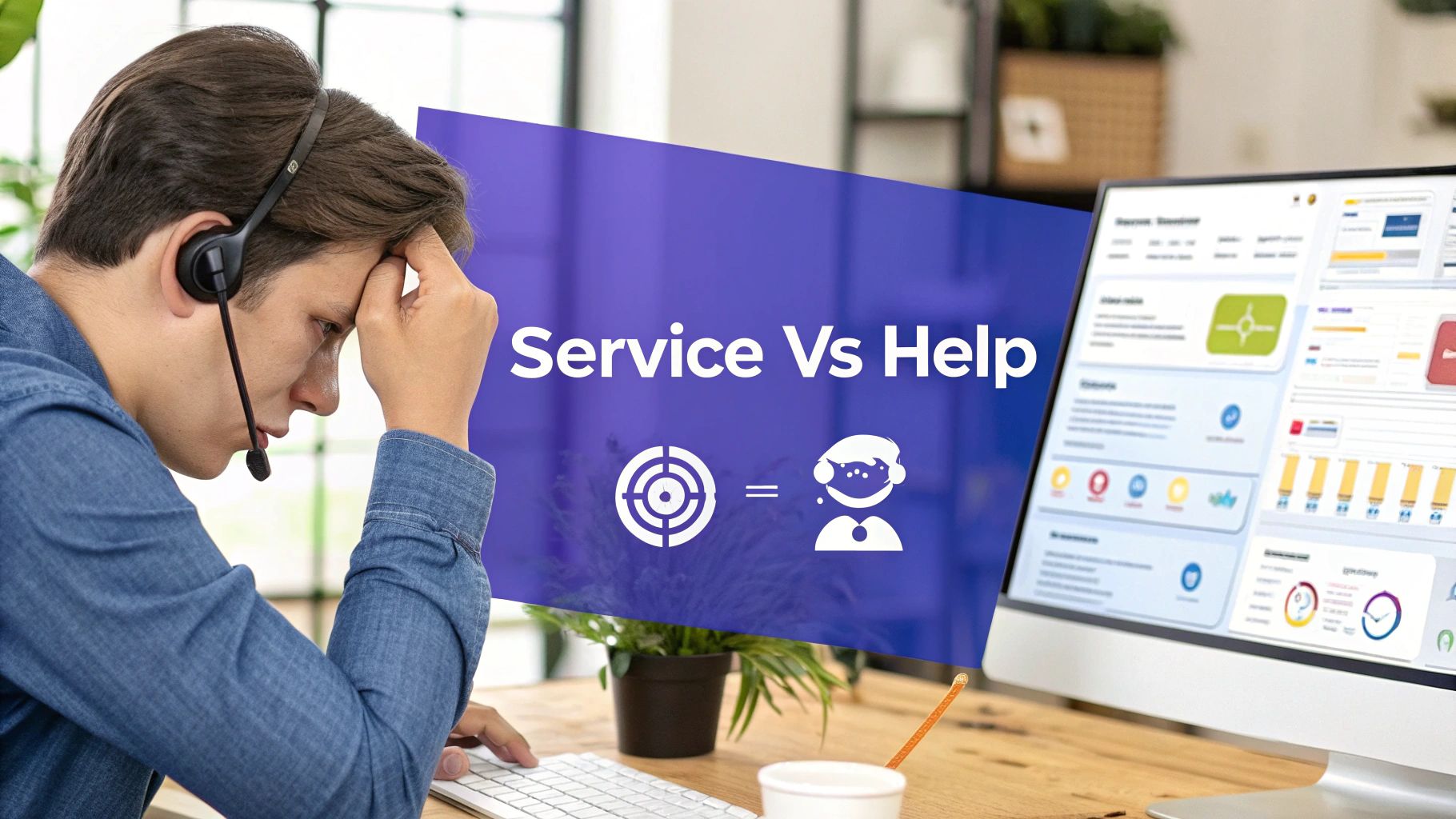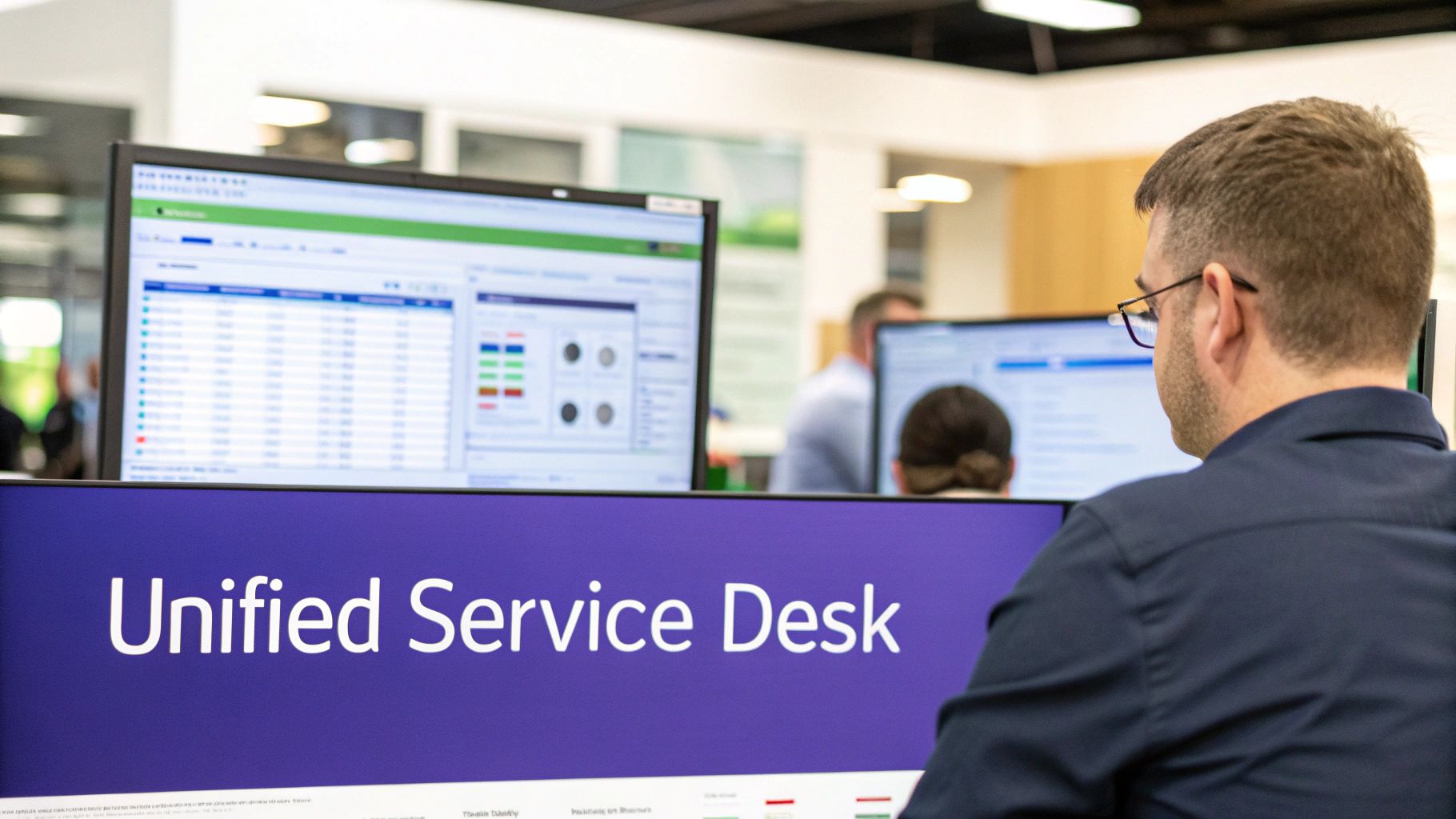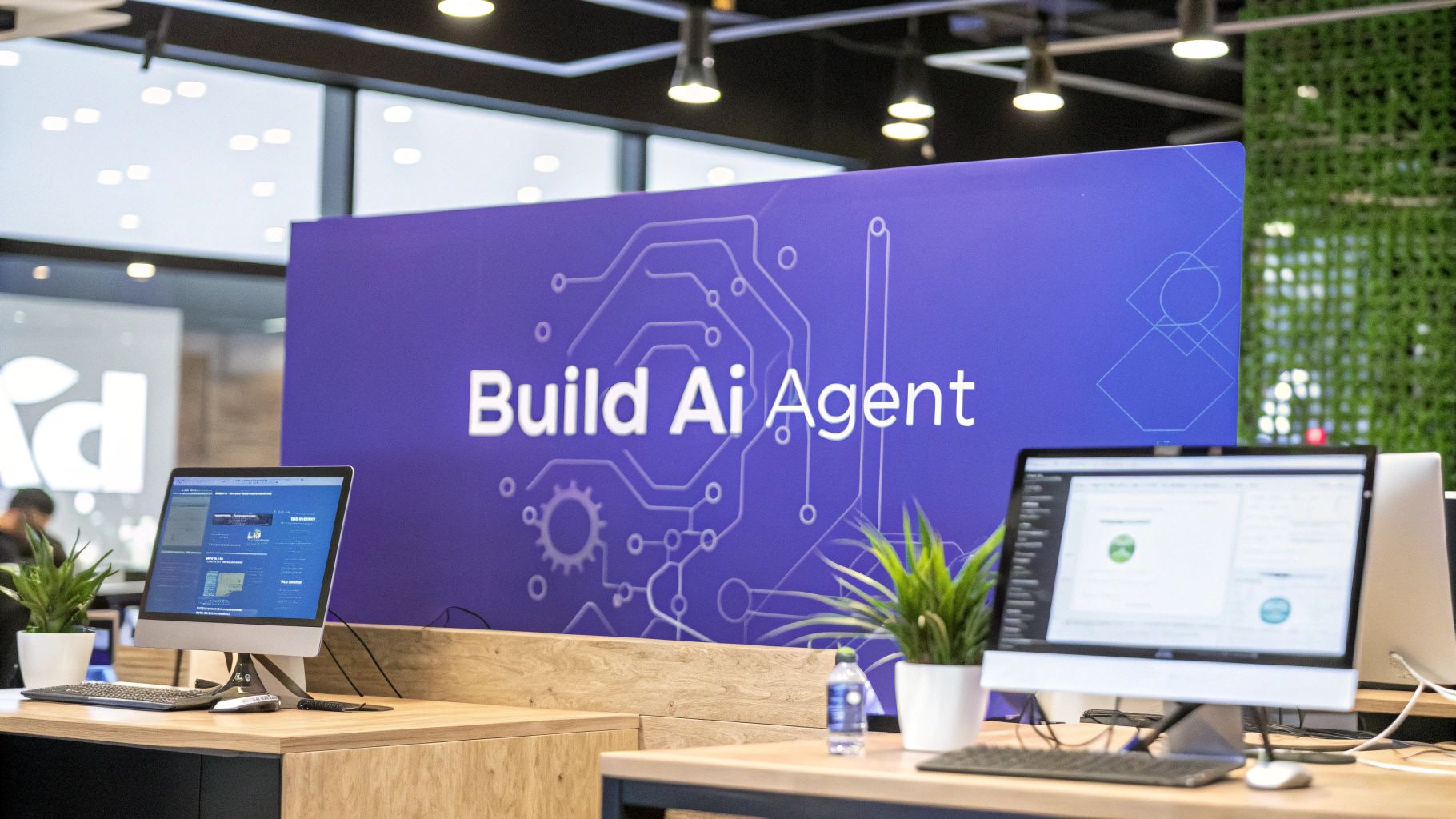Service Desk vs Help Desk Which Is Right for You?
Explore the real difference in the service desk vs help desk debate. This guide clarifies their roles and helps you choose the right IT support model.

The line between a help desk and a service desk often gets blurry. People use the terms interchangeably, but they represent two different philosophies for IT support. Understanding that difference is the first step to figuring out which model your business actually needs.
The core distinction comes down to focus. A help desk is tactical and reactive, built to fix immediate, individual tech problems. Think of it as the IT firefighter. A service desk is strategic and proactive, designed to manage the bigger picture of IT service delivery and make sure it aligns with what the business is trying to achieve.
Understanding the Fundamental Divide

Choosing between them is not just about words; it impacts everything from day-to-day user productivity to your long-term business strategy.
A help desk runs on a classic break-fix model. Its job is to react when things go wrong, a broken printer, a forgotten password, a software glitch, and resolve the issue as fast as possible. This is important for keeping employees online and minimizing downtime.
A service desk, however, takes a much broader view. It is the evolution of the help desk, incorporating principles from formal frameworks like IT Service Management (ITSM). It does not just fix problems as they pop up. It offers a full catalog of IT services, manages new service requests, and works to prevent issues from happening in the first place.
Key Functional Distinctions
The daily operations of each model really highlight the difference. A help desk ticket might be, “My laptop won’t connect to the Wi-Fi,” and the goal is to get that one laptop reconnected. Simple.
A service desk might handle that same incident, but it also manages the request for a new laptop, oversees its setup and software installation, tracks its lifecycle as a company asset, and analyzes why so many laptops are having connectivity issues in the first place.
For a clearer picture, here’s a quick summary of how they stack up.
At a Glance: Help Desk vs. Service Desk
A help desk is a component that can exist within the broader scope of a service desk. While a help desk solves today's problems, a service desk is busy trying to improve tomorrow's operations.
What Is the Role of a Help Desk?
Think of the help desk as the classic first responder for tech problems. Its role is fundamentally reactive, built on a simple break-fix model. When something breaks, a printer gives up, a password stops working, the help desk swoops in to provide a quick fix and get the user back to their day.
The main mission here is to restore normal service for one person as fast as possible. This tactical focus means help desk teams are masters at handling isolated incidents. They work through a queue of support tickets, prioritizing and knocking them down one by one.
The Tactical Approach to Support
A help desk's success is usually measured with specific, short-term metrics. Things like how fast a ticket is closed (time to resolution) and the immediate satisfaction of the user are what count. The tools they use reflect this, typically centering on ticketing systems designed to track and manage individual problems.
To get a feel for this traditional support function, you can look at the core of IT Helpdesk Support. This role is not really concerned with why a problem keeps happening; it’s all about how to fix the one right in front of them.
Here are a few classic help desk tasks:
- Resetting a forgotten user password.
- Troubleshooting a specific application error or software glitch.
- Fixing a piece of hardware, like a monitor that won't turn on.
- Helping out with basic network connection issues.
This reactive nature is a huge piece of the service desk vs help desk puzzle. While a service desk works to prevent issues from happening in the first place, a help desk is built to be an expert at solving them as they pop up. If you're looking to really nail this operational side, our guide on the best practices for your help desk has some great insights.
Perception vs Reality in IT Support
What’s interesting is how the term "help desk" has stuck around, even as IT support has grown up. User perception plays a massive part in this. Even when IT departments offer much broader services, about 95% of end-users still call their IT support team a 'help desk.'
It just goes to show how strong that legacy naming is. For most people, any kind of technical assistance is still associated with that traditional term. You can look into this user perception in studies on IT terminology.
How a Modern Service Desk Operates

A modern service desk is a far cry from the old break-fix model of a help desk. It functions more like an IT command center, aligning every tech service with the company's bigger goals. Its entire operation is built on the principles of IT Service Management (ITSM), which gives structure to how tech is planned, delivered, and improved across the business.
Think of the service desk as the single front door for all things IT, not just for reporting problems. This means an employee talks to the same team whether their laptop is glitching or they need access to new software. It creates a clear, consistent experience for everyone, ending the classic "who do I even ask for this?" confusion. This unified approach is a massive differentiator in the service desk vs help desk conversation.
This shift did not happen overnight. The original help desk, born in the '80s and '90s, was purely reactive. It was all about troubleshooting. The service desk concept came later, driven by the ITIL frameworks of the early 2000s, which pushed IT to be managed as a holistic service. You can get more information on the history of these support models to see how things evolved.
A Catalog of Proactive Services
Instead of just waiting for things to break, a service desk offers a clearly defined service catalog. You can think of it as a menu of every IT service available to employees, which gives them self-service options and makes IT operations predictable.
Common items in a service catalog include:
- New Hardware Requests: A structured process for an employee to get a new laptop or monitor.
- Software Access: Fulfilling requests for licenses to apps like Adobe Creative Suite or a project management tool.
- Onboarding and Offboarding: Managing all the IT tasks when someone joins or leaves the company.
This proactive stance prevents countless little issues from ever becoming help desk tickets. By standardizing the new-hire process, for example, the service desk makes sure every employee gets the right gear and access on day one. No more flood of "I can't log in" tickets. Our guide on using a chatbot for your service desk shows how automation can make these processes even smoother.
A key goal of the service desk is to stop incidents from happening in the first place. By analyzing recurring issues, its problem management function can find and fix the root cause, creating a more stable and reliable IT environment for the whole business.
Comparing Key IT Support Functions
To really get the service desk vs help desk distinction, you have to look at how they handle their day-to-day work. Their core functions might sound similar on the surface, but the way they approach each one reveals a completely different philosophy.
One is a master of the quick fix, while the other is playing a longer, more strategic game.
Let's break down four key areas to see how they differ in the real world. This is not just a list of features; it’s a look at two fundamentally different mindsets, one tactical, the other deeply tied to the business.
Incident Management
Incident Management is all about getting things back to normal after an unexpected disruption. Think of it as the IT version of firefighting, and it's the bread and butter of a traditional help desk.
- A help desk is purely reactive here. When a user reports their laptop won't connect to Wi-Fi, the help desk’s goal is simple: solve that one problem for that one user, as fast as possible. The ticket is opened, the issue is fixed, and the ticket is closed. End of story.
- A service desk, on the other hand, also resolves the immediate issue. But it takes things a step further by logging the incident's details for later analysis. The focus is not just on the fix; it’s about collecting data to spot trends.
This small difference in data collection is where everything starts. While the help desk moves on to the next fire, the service desk is already looking for smoke.
Problem Management
This is where the proactive nature of a service desk really shines. Problem Management is the process of finding and fixing the root cause of recurring incidents. It's a function that almost exclusively belongs to the service desk.
- A help desk does not really do formal Problem Management. If the same Wi-Fi issue is reported by ten different people, the help desk will simply create and resolve ten separate tickets. It’s efficient in the moment but doesn't solve the underlying issue.
- The service desk sees the pattern in the incident data. It opens a "problem" record to investigate why so many laptops are losing connection. That investigation might point to a faulty wireless access point, which then gets scheduled for replacement, preventing future incidents for everyone.
This is the game-changer. A help desk puts out fires; a service desk fireproofs the building. By getting to the source of recurring issues, the service desk drives down the overall incident volume and improves stability across the whole organization.
Service Request Fulfillment
A service request is a formal request from a user for something new, like access to an application, a new laptop, or a password reset. This is another area where the two models couldn't be more different.
- Help desks typically do not handle formal service requests. An employee might send an informal email asking for a new monitor, but there’s no standardized process, no approval workflow, and no real way to track it.
- Service desks manage these requests through a predefined service catalog. The user selects "New Monitor" from the catalog, the request is automatically routed to their manager for approval, and the IT team is notified to fulfill it. The entire process is trackable, repeatable, and consistent.
Change Management
Change Management makes sure that any changes to the IT environment, like a server upgrade or a new software rollout, are carried out with minimal disruption.
- A help desk is not equipped for this. Its focus is on fixing things that are already broken, not managing planned modifications to IT infrastructure. Changes just sort of happen, and the help desk deals with the fallout.
- A service desk treats this as a core discipline. It manages the entire lifecycle of a change, from planning and risk assessment to implementation and review. This structured process prevents the very outages that would otherwise flood the support team with new incidents.
To make these differences even clearer, let's look at them side-by-side.
Functional Comparison Help Desk vs Service Desk
The table below breaks down how each support model handles key IT functions. Notice how the help desk focuses on immediate, tactical responses, while the service desk takes a broader, more strategic view aimed at aligning with business goals.
As you can see, the help desk is a helpful component of IT support, but its scope is limited to break-fix. The service desk, in contrast, is designed to be a single point of contact for all things IT, integrating seamlessly with broader business objectives.
How to Choose the Right Model for Your Business
Deciding between a service desk and a help desk is not about picking the "best" one. It's about finding the right fit for where your business is right now. There's no one-size-fits-all answer. Your choice will come down to your company's size, the complexity of your IT, and what you want to achieve long-term.
For a smaller business with pretty straightforward tech needs, a help desk is almost always the perfect starting point. Its reactive, break-fix model is built for speed. When an employee needs a password reset or a piece of software is acting up, the goal is simple: solve the immediate problem and get them back to work.
This is the core choice you're making: do you need a reactive or proactive IT support model?

As the infographic highlights, a help desk is designed for tactical, in-the-moment support. A service desk is built for a strategic, big-picture approach.
When Your Business Needs a Service Desk
As your company grows, technology stops being just a utility and becomes a critical part of how you operate. This is when a service desk becomes the logical next step. When making this call, it's also helpful to consider how different work models might influence your organizational structure and service needs.
A service desk is the smarter choice in these situations:
- You're Scaling Rapidly: If you're hiring fast, a service desk can standardize the entire onboarding process. It makes sure every new team member gets the right hardware, software access, and permissions from day one.
- IT Downtime Is a Major Risk: For businesses where even a minor outage hits the bottom line, the proactive problem management of a service desk is important. It’s designed to spot and fix issues before they can disrupt operations.
- You Need to Align IT with Business Goals: When technology needs to actively support specific business objectives, like a new product launch or market expansion, a service desk provides the strategic oversight to make it happen.
The core question to ask is this: "Is our IT support just fixing today's problems, or is it helping us build a more efficient and stable business for tomorrow?" Your answer will point you directly to the right model.
The Business Impact of Your IT Support Choice

The choice between a service desk and a help desk is not just about IT jargon. It’s a decision that hits your company’s bottom line, shaping everything from employee productivity to your ability to scale. This is where technical processes meet real-world business results.
A solid help desk keeps individual users moving. When an employee's software crashes, a quick fix from the help desk gets them back to work. This kind of tactical support is great for minimizing small pockets of downtime and keeping daily tasks on track.
But a service desk? That delivers a much broader, more strategic impact. By leaning on ITSM processes, it moves beyond simple fixes to improve the entire operational backbone of the business. It’s a proactive approach with a measurable effect on company performance.
From Cost Center to Value Driver
Let's be honest: a help desk is often seen as a necessary cost. Its job is to fix things that are already broken. A service desk, on the other hand, is designed to create value. By getting ahead of issues before they happen, it drives down the overall cost of IT support and cuts down on the system-wide downtime that can bring a business to a halt.
The numbers back this up. Research shows that organizations using ITIL-based service desk frameworks see up to 40-50% faster incident resolution times. Even better, their proactive problem management leads to a reported 30% decrease in repeat incidents, which translates directly to cost savings and a more stable environment. You can look into these service desk findings for more detail.
Aligning Technology with Company Goals
Maybe the most important impact is strategic alignment. A true service desk makes sure that technology serves the business, not the other way around. It delivers the data and oversight leaders need to make smart decisions about technology investments, helping the company adapt and grow without friction.
This is why the service desk vs help desk discussion is so important for any business with plans to scale. Fine-tuning these support processes is a huge part of growing sustainably, and modern tools can make a massive difference. For instance, exploring help desk automation can free up your team to focus on more strategic work, no matter which model you choose.
Common Questions About Help Desk vs. Service Desk
When you're trying to nail down the difference between a service desk and a help desk, a few specific questions always seem to pop up. Let's clear up the most common ones.
Can a Business Have Both a Help Desk and a Service Desk?
Absolutely. In fact, it's pretty common in larger companies to have both.
When this happens, the help desk usually acts as a component within the larger service desk framework. Think of it this way: the help desk is your frontline, handling the immediate, break-fix incidents, your classic "Level 1" support. The service desk, on the other hand, oversees the whole show, managing escalations, handling service requests, and analyzing incident data to get ahead of future problems.
How Do You Transition from a Help Desk to a Service Desk?
Moving from a help desk to a service desk is a full strategic project, not just a simple name change. It’s about adopting a more holistic IT Service Management (ITSM) approach, often guided by a framework like ITIL.
The move usually involves a few key steps:
- Defining a Service Catalog: First, you have to create a clear, accessible menu of all the IT services you offer to the rest of the business.
- Implementing New Processes: This means introducing formal procedures for things like problem management, change management, and fulfilling service requests.
- Investing in the Right Tools: You'll need to graduate from a basic ticketing system to a more robust ITSM platform that can manage the entire service lifecycle.
- Training Your Team: This is a big one. You have to shift the team's mindset from purely reactive fixes to proactive service delivery that aligns with what the business actually needs.
How Does Automation Differ Between a Help Desk and a Service Desk?
Automation shows up differently in each model because their core goals are not the same.
A help desk uses automation for tactical efficiency, like auto-assigning tickets to the right person. A service desk uses automation for strategic improvement, like streamlining the entire new-hire onboarding workflow from start to finish.
In a help desk, automation is all about speeding up incident resolution. For a service desk, automation is used to build seamless, end-to-end workflows that might connect different business departments and ultimately improve the overall employee experience.
Ready to see how an AI agent can automate and improve your IT support? Chatiant lets you build a custom chatbot that can handle service requests, answer common questions, and integrate with your existing tools. Learn more about Chatiant.


